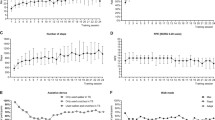Abstract
Background
Motor impairment and loss of ambulatory function are major consequences of a spinal cord injury (SCI). Exoskeletons are robotic devices that allow SCI patients with limited ambulatory function to walk. The mean walking speed of SCI patients using an exoskeleton is low: 0.26 m/s. Moreover, literature shows that a minimum speed of 0.59 m/s is required to replace wheelchairs in the community.
Objective
To investigate the highest ambulatory speed for SCI patients in a Lokomat.
Methods
This clinical pilot study took place in the Rehabilitation Center Kladruby, in Kladruby (Czech Republic). Six persons with motor-complete sub-acute SCI were recruited. Measurements were taken at baseline and directly after a 30 min Lokomat training. The highest achieved walking speed, vital parameters (respiratory frequency, heart rate, and blood pressure), visual analog scale for pain, and modified Ashworth scale for spasticity were recorded for each person.
Results
The highest reached walking speed in the Lokomat was on average 0.63 m/s (SD 0.03 m/s). No negative effects on the vital parameters, pain, or spasticity were observed. A significant decrease in pain after the Lokomat training was observed: 95% CI [0.336, 1.664] (p = 0.012).
Conclusion
This study shows that it is possible for motor-complete SCI individuals to ambulate faster on a Lokomat (on average 0.63 m/s) than what is currently possible with over-ground exoskeletons. No negative effects were observed while ambulating on a Lokomat. Further research investigating walking speed in exoskeletons after SCI is recommended.




Similar content being viewed by others
Abbreviations
- SCI:
-
Spinal cord injury
- VAS:
-
Visual analog scale
- SD:
-
Standard deviation
References
Andrews AW, Chinworth SA, Bourassa M, Garvin M, Benton D, Tanner S (2010) Update on distance and velocity requirements for community ambulation. J Geriatr Phys Ther 33(3):128–134
Chen G, Chan CK, Guo Z, Yu H (2013) A review of lower extremity assistive robotic exoskeletons in rehabilitation therapy. Crit Rev Biomed Eng 41(4–5):343–363
Louie DR, Eng JJ, Lam T (2015) Gait speed using powered robotic exoskeletons after spinal cord injury: a systematic review and correlational study. J Neuroeng Rehabil 12(1):1–10
Sandrow-Feinberg HR, Houlé JD (2015) Exercise after spinal cord injury as an agent for neuroprotection, regeneration and rehabilitation. Brain Res 1619:12–21
Van Hedel HJA, Severini G, Scarton A et al (2018) Advanced Robotic Therapy Integrated Centers (ARTIC): an international collaboration facilitating the application of rehabilitation technologies. J Neuroeng Rehabil 15(1):30
Van Silfhout L, Hosman AJF, Bartels RHMA et al (2017) Ten meters walking speed in spinal cord-injured patients: does speed predict who walks and who rolls? Neurorehabil Neural Repair 31(9):842–850
Author information
Authors and Affiliations
Contributions
LvS was involved in the study concept and design, analysis and interpretation of the data, drafting the manuscript, and revising the final manuscript. JP and ZV were involved in the acquisition of data and critical revision of the manuscript. AH and HvdM were involved in the study design, data analysis and interpretation, and critical revision of the manuscript. ME and RB were involved in the data analysis and interpretation, and drafting and revising the manuscript.
Corresponding author
Ethics declarations
Competing interests
The authors declare that they have no competing interests.
Ethics approval and consent to participate
Approval of the local ethics committee was obtained for this study, and informed consent was obtained from the participants of this study.
Availability of data and material
All data generated and analyzed during this study are available from the corresponding author on reasonable request.
Additional information
Publisher’s note
Springer Nature remains neutral with regard to jurisdictional claims in published maps and institutional affiliations.
This article is part of the Topical Collection on Spine trauma
Rights and permissions
About this article
Cite this article
van Silfhout, L., Váňa, Z., Pĕtioký, J. et al. Highest ambulatory speed using Lokomat gait training for individuals with a motor-complete spinal cord injury: a clinical pilot study. Acta Neurochir 162, 951–956 (2020). https://doi.org/10.1007/s00701-019-04189-5
Received:
Accepted:
Published:
Issue Date:
DOI: https://doi.org/10.1007/s00701-019-04189-5




